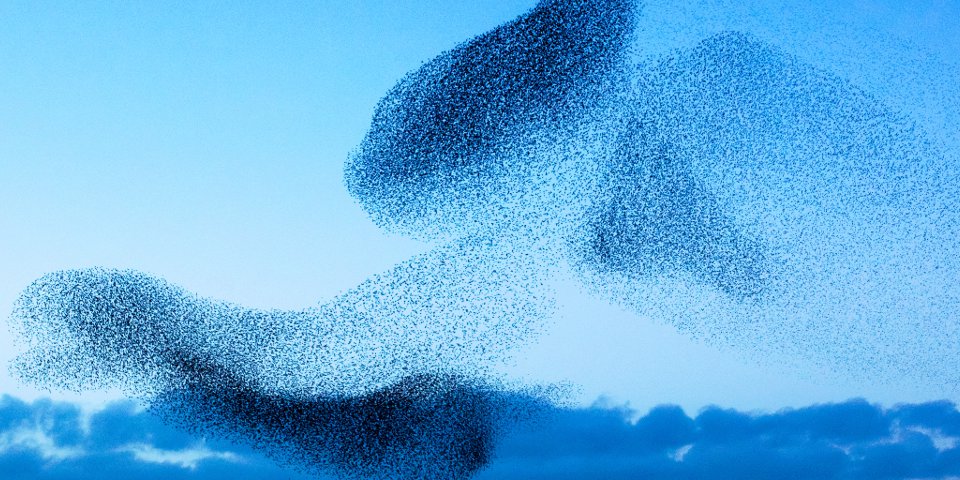Active or passive?
Contributing to the market versus disturbing the market.

Contributing to the market versus disturbing the market.

Every August millions of starlings from countries in northern Europe migrate southwest. And each spring they return to their breeding grounds. How do they navigate?
As it turns out, no bird is able to find its way on its own. The primary strategy of each bird is to maintain a roughly equal distance from the other birds flying in front, beside, above and below. Starlings fly with their flock. But how does the flock navigate?
Well, birds have more strategies besides their primary. No bird can find its way on its own, but there are many birds that each hold a piece of useful information. Innately, they sense magnetic fields. Some experienced birds recognize coastlines that they have seen before on previous migrations. Others recognize motorways, large buildings, or other distinctive landmarks. Then there are other birds who rely on elements of nature to guide them: the bend in a river, a star constellation or particular reflections made by the sun. When flying within a flock, the birds that recognize a river, for instance, might bear somewhat to the right. And the others will follow.
The greater the number of birds carrying valid information, the faster the flock will reach its destination. Theoretical experiments have shown that if the number of birds with valid information is less than the square root of the total number of birds, the flock will get lost. This could be problematic for a flock of only 25 birds; one out of every five would need to have valid information. But for a flock of a million birds, this is no problem at all. Migrating birds are a living example of the wisdom of crowds.
For markets to function, there should be a continuous interaction between prices, supply and demand.
Markets are comparable to a flock of starlings. In a well-functioning market, the price ‘migrates’ to the level where supply meets demand. No individual market participant has full knowledge about all supply and demand factors. The basic strategy is to fly with the flock. No one is willing to pay seven when the market just traded at six. Nor will anyone be willing to sell at five. But merely flying with the flock won’t do the trick. To make the market function properly, it is essential that participants who know about (potential) supply, that others are not aware of, are willing to sell at a lower price; and that those who know about (potential) demand are willing to buy at a higher price. Only in this way are prices meaningful, and thus expressing the wisdom of the crowd.
Supply and demand are fundamental in this equation. The purpose of markets is not to make investors happy with rising prices. For markets to function, there should be a continuous interaction between prices, supply and demand. For instance, when shortage looms, prices should rise in time to give producers an incentive to raise their production and/or to give consumers an incentive to find alternatives. Without such interaction, markets would sway in wide swings from over-supply to over-demand, as we all know from (historical) economies without well-functioning markets. This mechanism will be immediately clear in commodity markets. But, indirectly, the same principle holds true for financial markets. For instance, the value of a company should rise if the goods or services that it produces are in demand. And if not, it should not.

Markets are comparable to a flock of starlings
Back to the starlings. It is understandable that parent birds instruct their youngsters in August to “just fly with the flock”. But the species would not have survived a million years of evolution if the young birds weren’t willful. Despite being told this, they looked around anyway and learned to orient and navigate by themselves.
The investment equivalent of “just fly with the flock” is passive investing. Don’t examine markets and prices, just follow the index. If unexperienced, small-sized private investors choose to employ such an investment strategy, they could be excused. But if professional investors refrain from using any navigational skills, how can we expect markets to continue to function?
Everyone who knows the basics of finance knows the answer: we can’t. But in the behavioral sciences, fashions can be stronger than wisdom. You can now even read articles from financial professors, who claim that active investing is senseless – thereby completely neglecting more than a century of theory, experiences and lessons learned in financial markets. With such professors teaching our next generation of financial markets professionals, we can only hope that most students are as willful as the average young starling!
The investment equivalent of “just fly with the flock” is passive investing.
Their argument: active investors (on average) do not outperform passive indices. That could be a valid argument if outperforming a passive index was a sensible investment goal. But that has never been the case. The bird that recognizes the river does not bear slightly to the right because she wants to outfly the other birds; she bears right because she’s striving to reach her winter residence. And by doing so, she helps the whole flock to reach that goal. A bird that strives to outfly the other birds will stay with the flock all the way, only to make a sprint in the last mile. This doesn’t help the flock. Such birds did not survive evolution.
A truly active investor strives for absolute returns. To achieve this goal, she buys things or values when she believes them to be undervalued; and she will sell them when she believes them to be overvalued. And if she does this well, she contributes towards well-functioning markets. Passive investors and investors that strive to outperform an index do not fulfill this role. Their existence is purely parasitic. If they overwhelm the marketplace, the market doesn’t function. This is a risk for all investors. And, detrimentally, this leads to supply and demand imbalances in the real economy. What reasonable investor would want to be responsible for that?
Is this too abstract? Let us give an example that by now should be textbook material: the credit crisis of 2007 and 2008. Many blame the banks for this crisis. And indeed, banks do deserve a large part of the blame. But if we blame the banks, we can only blame the ones responsible for the activities of the banks. High on that list are the ones who own the banks; that is, the investors holding the banks’ equity. Many of these investors might regard themselves as victims of the credit crisis, but in essence, they aren’t. They are among the culprits. At a minimum, they should be blamed for remaining passive when the market required them to take responsibility the most.
When the management of banks chose to become open-handed with lending, when the management of banks chose to reduce their capital levels, the shareholders could have raised their hands at the shareholders meeting, questioning the riskiness of this behavior. And those who didn’t want to raise a hand or their voice, could have spoken with their feet. Recognizing this unprecedented risk, that was measurable with all standard risk measures, they could have chosen to protect their capital and sell their stocks. But they didn’t. And the passive investors surely didn’t. They incited this bank policy by buying more and more of the banks’ equity. Between 2000 and 2007, passive equity investors tracking the S&P500-index increased their investments in financials from less than 15% to more than 22% of their capital. And Dutch investors tracking the Amsterdam AEX-index increased their investment in financials to more than 35%.

Yes, these investors lost in the market sell-off from the second half of 2008. But the real victim was the real economy. The non-functioning markets fueled a pendulum swing from over-supply to over-demand. First there was an over-supply of loans; anyone could borrow from a bank. And then there was an over-demand; almost nobody could get a loan. First there was an over-demand for houses; houses were sold over their asking prices. And then there was an over-supply of houses; the housing market came to a complete stand-still. This way, the crisis in the financial markets became a crisis resulting in millions of victims in the real economy.
Passive investing did not protect investors from losing capital in this crisis. Passive investing contributed to the source of the crisis. But what have investors learned from this? Passive investing has become even more popular. In The Netherlands, even the central bank is effectively encouraging passive investing, without giving any indication how passive investing could lead to well-functioning markets. Will this pave the way for another crisis? Not necessarily. The fact that a central bank in this respect feels no urge to remind investors of their responsibility for well-functioning markets does not relieve investors from that responsibility. Markets will function if we, the investors, make them function. Every investor who considers herself at least as smart and responsible as a starling can play an active role in that.
What is Transtrend’s position in the marketplace? Isn’t a trend following program like DTP just an extreme example of ”flying with the flock”?
In the starling analogy, we are indeed not among the birds following the rivers or the stars. We are typically among the birds that fly in the second or third row of the flock. When some of the birds ahead of us bear to the right, we decide whether to follow them or not. If we make the right pick, we help the flock reach its goal. If we make the wrong pick, we become part of the problem.
We have noticed that since 2008, due to the growing magnitude of uninformed price moves, it has become harder to make the right pick. We realized that we had to improve our program to keep us on the right course. We found these improvements in many layers of the program. One of them is the trend identification layer, which essentially determines which birds can reliably be followed.
Another layer that was improved is the portfolio construction layer. Therein lies another piece of valid information that DTP can bring to the market. Investors following market cap weighted indices typically buy into bubbles, like they did in banks in the period running up to the credit crisis. The risk measures within DTP are designed to recognize such expanding risk concentrations. And then the program actively trades out of them. Due to this mechanism, DTP tends to sell in massively inflated markets. And DTP tends to buy in rapidly falling markets. So, this bird may fly with the flock most of the time. But when the flock overreacts, this informed bird diverts its course away from it.
The crucial element of course is that DTP is a truly absolute return strategy. We regularly review the performance of the program, irrespective of the performance of more or less passive indices. And in this analysis we do watch ‘rivers and stars’. If we conclude that the strategy is not in sync with the market dynamics, we look for improvements.